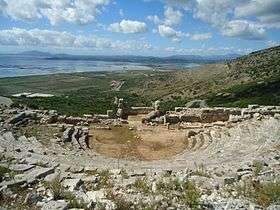Pleuron, Aetolia

Pleuron (Ancient Greek: Πλευρών, gen.: Πλευρῶνος; Greek: Πλευρώνα, Plevrona or Ασφακοβούνι, Asfakovouni) was an ancient city in Aetolia, Greece. It was the birthplace of the ancient Greek poet Alexander Aetolus.
According to Strabo[1] the name refers to two settlements, the older of which was at the foot of Mt. Kurios between the river Acheloos and the river Euenos, and was mentioned by Homer.[2] The ruins of this more ancient city are north of the newer one and consist of a few remnants of Cyclopean walls.
Pleuron[3] was founded by the Kouretes; or Thoas, son of Aeneas, guided the Aitolians there. When Demetrios II of Macedon destroyed Pleuron in 234 BC, the inhabitants founded a new city on the uplands of Arakinthos. Founder of the city was most probably Pantaleon of Pleuron, strategos of the Aetolian League in 242/41, 235/34, 228/27, 222/21 and 214/13.
Some time after the defeat of the Aetolian League in the Roman–Seleucid War, the citizens of Pleuron asked the Roman Senate a special permission to join the Achaean League. After the Achaean defeat and the destruction of Corinth in 146 BC Pleuron became part of the Roman Empire. During the Imperial age the uprisings in Aetolia continued.
Nea Pleuron has been identified in the locality of the castle of Κυρίας Εἰρήνης. The remains[4] are located a few kilometers north of the modern city of Missolonghi (and just west of the ancient city of Calydon, with which is it sometimes associated).
The city occupies a terrace at over 200m altitude, and is linked to the sea by a defence wall that also encircles the ancient port of Elaius.
The city wall is rectangular with 7 gates and 31 towers. The masonry is well preserved almost everywhere and partly trapezoidal, partly pseudo-isodomic with squared faces and datable to ca. 230 BC. The acropolis occupies the upper part of the site, but little remains. A Byzantine chapel was built on the remains of the Temple of Athena. The civil buildings are to the south. The theatre is in the south-west part of the city with the proscenium built against the city wall. The central part of the building housing the skena is a tower. The proscenium had six columns, and the parascenia must have been elevated above it and must have leaned against the wall. The circle of the orchestra is tangental to the skena. The cavea, well preserved at the north, had five sections and six staircases. The construction of the theatre is contemporary with the walls.
Other areas recognisable in the city include the site of the agora, with a 62 m long stoa, and the gymnasium. To the south east was a large communal cistern (30 x 20 m) with five rectangular basins. There are also remains of unidentifiable public buildings and extensive remnants of houses and cisterns. The necropolis extends to the south of the city.
References
- ↑ Strab. 10.451
- ↑ Iliad 2.638
- ↑ Strabo 10.461
- ↑ "Pleuron: recent archaeology!", http://eu.camperistas.com/1139/pleuron-kalidona/
Coordinates: 38°24′55″N 21°24′51″E / 38.4153°N 21.4143°E